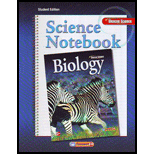
Concept explainers
To determine:
Definition of term prophase, sister chromatid, centromere, spindle apparatus, metaphase, anaphase, and telophase.
Introduction :
The cell is the basic unit of life and the series of events that takes place in a living cell during its life is known as the cell cycle. In the last M stage or the mitotic phase of the cell cycle, the cell is divided into two. The mitosis itself is divided into four sub-stages, these are prophase, metaphase, anaphase, and telophase.
Explanation of Solution
Prophase: The first phase of the mitotic division is prophase. In the cells, the genetic material is present in an uncoiled manner. So, for the cell division to occur, the DNA (deoxyribonucleic acid) needs to be condensed to form a chromosome. In a eukaryotic cell, the prophase starts with condensation of the DNA to form chromosomes and the nuclear membrane disappears.
Sister chromatid: It is identical copies of chromatids, replication of a chromosome. These sister chromatids are joined together at a common centromere.
Centromere: It is the center of the chromosome at which spindle fibers attach to the sister chromatids.
Spindle apparatus: It is a protein structure, which divide the chromosome of the parent cells equally into two parts, which forms the chromosome of the daughter cells.
Metaphase: The next phase to prophase is metaphase, at this stage, the condensed chromosomes lie at the equator of the cells.
Anaphase: At this stage, the pull of spindle fibers causes the separation of sister chromatids of chromosomes and leads to the movement of the chromatids to opposite poles. At the end of the anaphase, the movement of the chromatids to the opposite pole is completed.
Telophase: It is the last phase of the cell division, in which the chromosomes decondense at the opposite ends and nuclear envelop of the future daughter cells are formed.
Additional Science Textbook Solutions
Biology: Life on Earth
Biology: Life on Earth (11th Edition)
Concepts of Genetics (12th Edition)
Campbell Essential Biology with Physiology (5th Edition)
Campbell Biology in Focus
Genetic Analysis: An Integrated Approach (3rd Edition)
 Human Anatomy & Physiology (11th Edition)BiologyISBN:9780134580999Author:Elaine N. Marieb, Katja N. HoehnPublisher:PEARSON
Human Anatomy & Physiology (11th Edition)BiologyISBN:9780134580999Author:Elaine N. Marieb, Katja N. HoehnPublisher:PEARSON Biology 2eBiologyISBN:9781947172517Author:Matthew Douglas, Jung Choi, Mary Ann ClarkPublisher:OpenStax
Biology 2eBiologyISBN:9781947172517Author:Matthew Douglas, Jung Choi, Mary Ann ClarkPublisher:OpenStax Anatomy & PhysiologyBiologyISBN:9781259398629Author:McKinley, Michael P., O'loughlin, Valerie Dean, Bidle, Theresa StouterPublisher:Mcgraw Hill Education,
Anatomy & PhysiologyBiologyISBN:9781259398629Author:McKinley, Michael P., O'loughlin, Valerie Dean, Bidle, Theresa StouterPublisher:Mcgraw Hill Education, Molecular Biology of the Cell (Sixth Edition)BiologyISBN:9780815344322Author:Bruce Alberts, Alexander D. Johnson, Julian Lewis, David Morgan, Martin Raff, Keith Roberts, Peter WalterPublisher:W. W. Norton & Company
Molecular Biology of the Cell (Sixth Edition)BiologyISBN:9780815344322Author:Bruce Alberts, Alexander D. Johnson, Julian Lewis, David Morgan, Martin Raff, Keith Roberts, Peter WalterPublisher:W. W. Norton & Company Laboratory Manual For Human Anatomy & PhysiologyBiologyISBN:9781260159363Author:Martin, Terry R., Prentice-craver, CynthiaPublisher:McGraw-Hill Publishing Co.
Laboratory Manual For Human Anatomy & PhysiologyBiologyISBN:9781260159363Author:Martin, Terry R., Prentice-craver, CynthiaPublisher:McGraw-Hill Publishing Co. Inquiry Into Life (16th Edition)BiologyISBN:9781260231700Author:Sylvia S. Mader, Michael WindelspechtPublisher:McGraw Hill Education
Inquiry Into Life (16th Edition)BiologyISBN:9781260231700Author:Sylvia S. Mader, Michael WindelspechtPublisher:McGraw Hill Education





